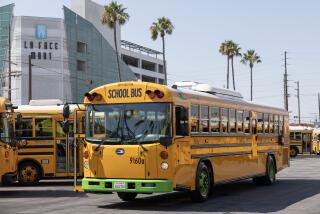And the Winner This Year Is . . . Education
Did Gov. George Deukmejian cave in to education Establishment pressure in this year’s budget? Did state Supt. of Public Instruction Bill Honig sell out to the governor in return for a few dollars? These are the questions that the press corps was asking as the 1988-89 budget was unveiled last week. Unfortunately, they are still asking the wrong questions. The key element in the education issue is quality learning, not a feud between the governor and the superintendent. Are taxpayers, parents and students getting full value from the education dollar?
Under the governor’s proposal, state general-fund support for kindergarten-through-12th-grade education would grow faster than the projected increase in taxes to be collected by the state. California is now spending $3,666 per student. This is the highest amount ever in public support of education in the state, even after adjusting for inflation.
What is significant and important is that the governor has chosen to buy specific education improvements with a portion of this new money. More than $100 million is going to targeted programs.
The governor’s education initiatives include a great expansion in summer-school programs to help students obtain the credits for high-school graduation or for college admission. Up to 7% of the student enrollment would be supported in summer school.
In order to improve the public’s information on the quality of California education, Deukmejian proposes to expand the California Assessment Program to include 10th grade and to revise tests for the 3rd, 6th, 8th and 12th grades. Many schools do not like this annual assessment of their students’ knowledge, but parents and taxpayers have found it to be a valuable index in rating schools.
A major increase in funds for acquiring textbooks and other educational materials is part of this budget. Honig and the state Board of Education have been pushing for new textbooks to be of markedly better content. Now is the time to purchase these improved texts.
One of the most successful programs is the School Improvement Program. It provides funds to be spent at the school by a school site council that best knows the school’s needs. Many legislators, myself included, see this program as a model for improving other programs that are unduly complex and bureaucratic or that are targeted inappropriately by politically inspired formulas. Here the governor is proposing a major increase that would permit the program to be extended from the elementary level into grades 7 and 8.
The special-education program is being given another boost by the governor with a $64-million increase for our 412,000 handicapped and learning-disabled students.
In a separate fund, Deukmejian is again proposing that $100 million be spent on new school buses. Many, if not most, of the buses that are now in operation are unsafe and polluting, and should be junked.
Our proud public-school system in California was not built in a day, nor was it brought low overnight. It took years of public support to build this system, and years of ignorance and social engineering in the 1970s to bring it down. Since 1983 we have been on a steady track of improvements, but we have a long way to go.
Perhaps the big budget fight of 1988 over our schools will be the continuing battle over class size and teachers’ salaries. Class sizes are large, and teachers’ salaries--particularly for the senior teacher--are not competitive. Yet each year no new money for schools is allocated to address these needs. Educators and parents like to see more of this money go into the classroom. There is a bill pending that would require 55% of a district’s total budget to be spent on teachers. Districts not meeting this standard can comply by hiring more teachers, by paying teachers better, or both.
In 1988-89 Deukmejian is proposing more than $1 billion in new money for schools, based on inflation and growth over and above these targeted expenditures. There is every reason to demand that these new funds be spent mostly in the classroom. What a difference it could make in quality if the teaching professionals who work directly with our children received the benefit of the proposed increases for education. Education excellence demands a commitment of dollars in the classroom.
More to Read
Sign up for Essential California
The most important California stories and recommendations in your inbox every morning.
You may occasionally receive promotional content from the Los Angeles Times.










